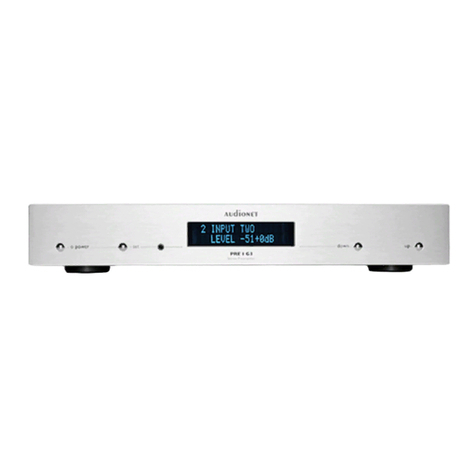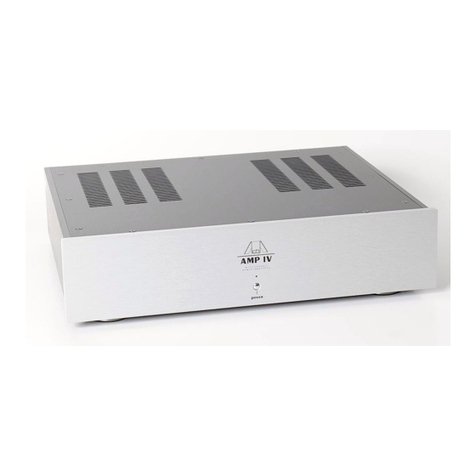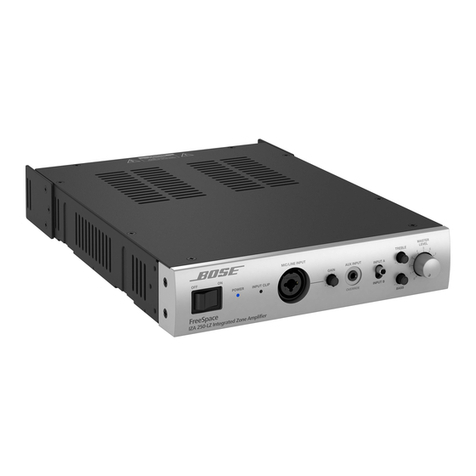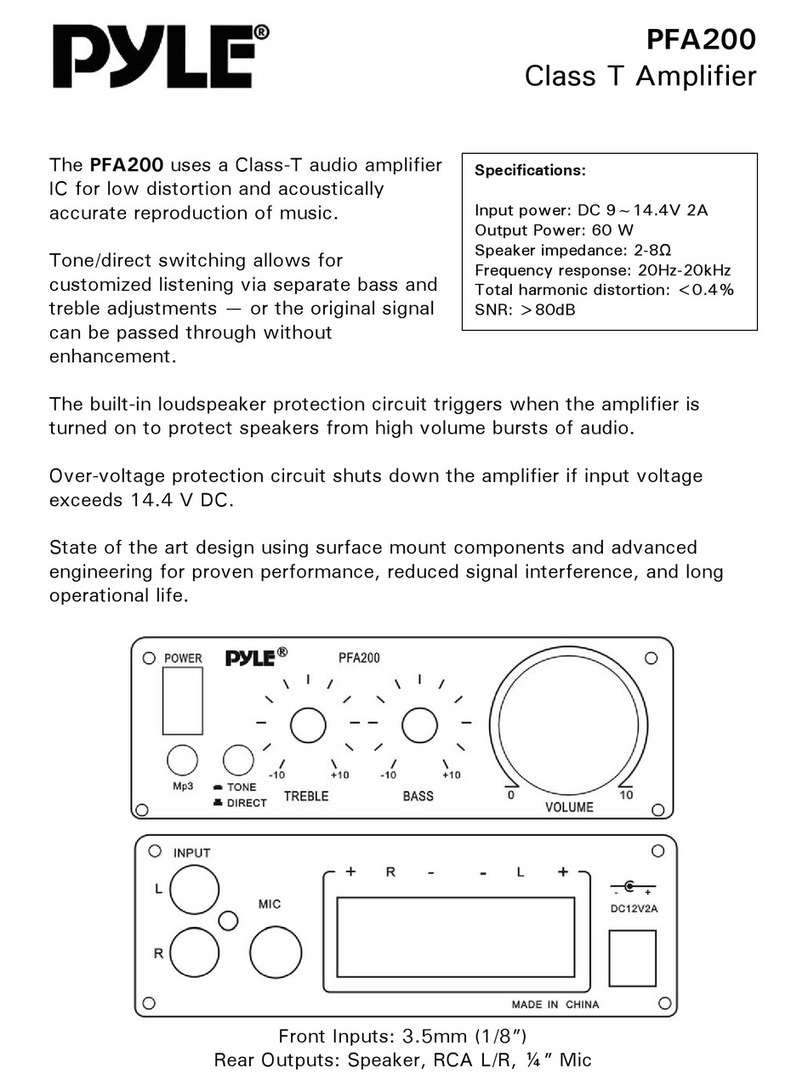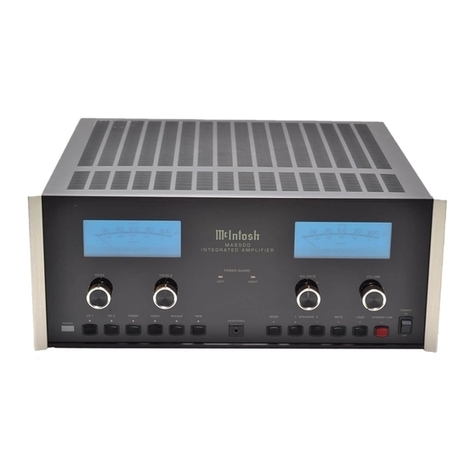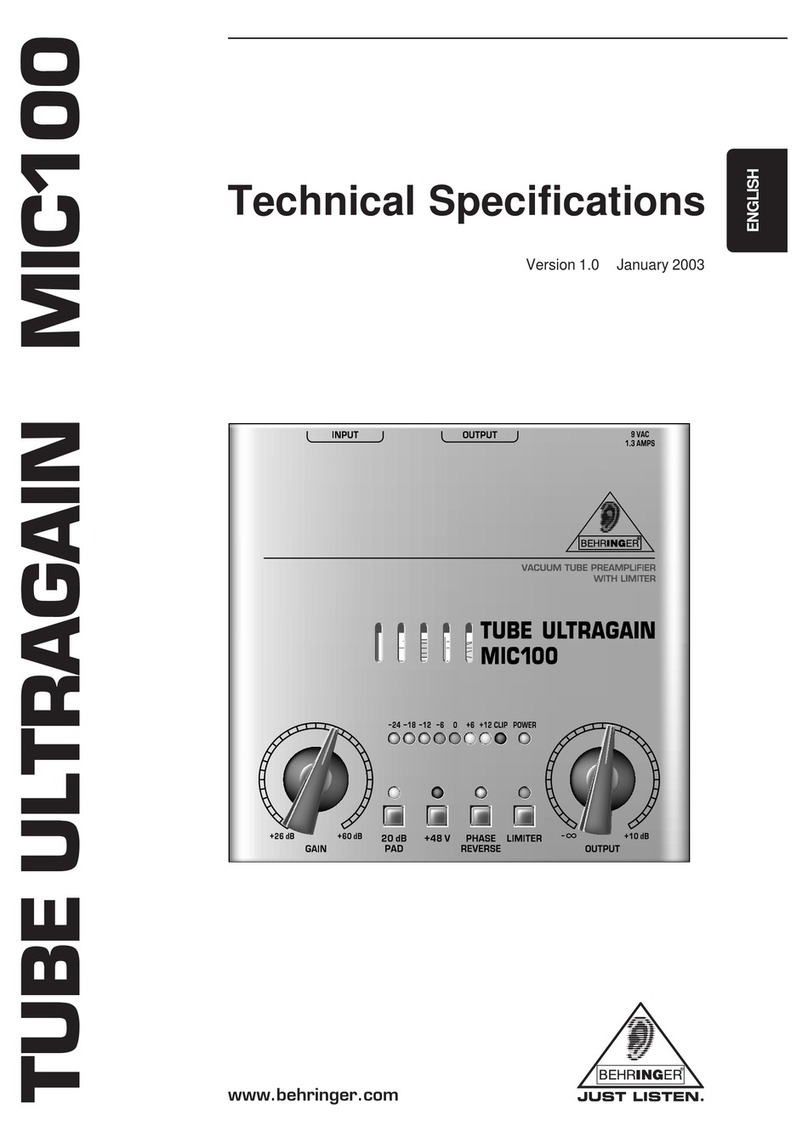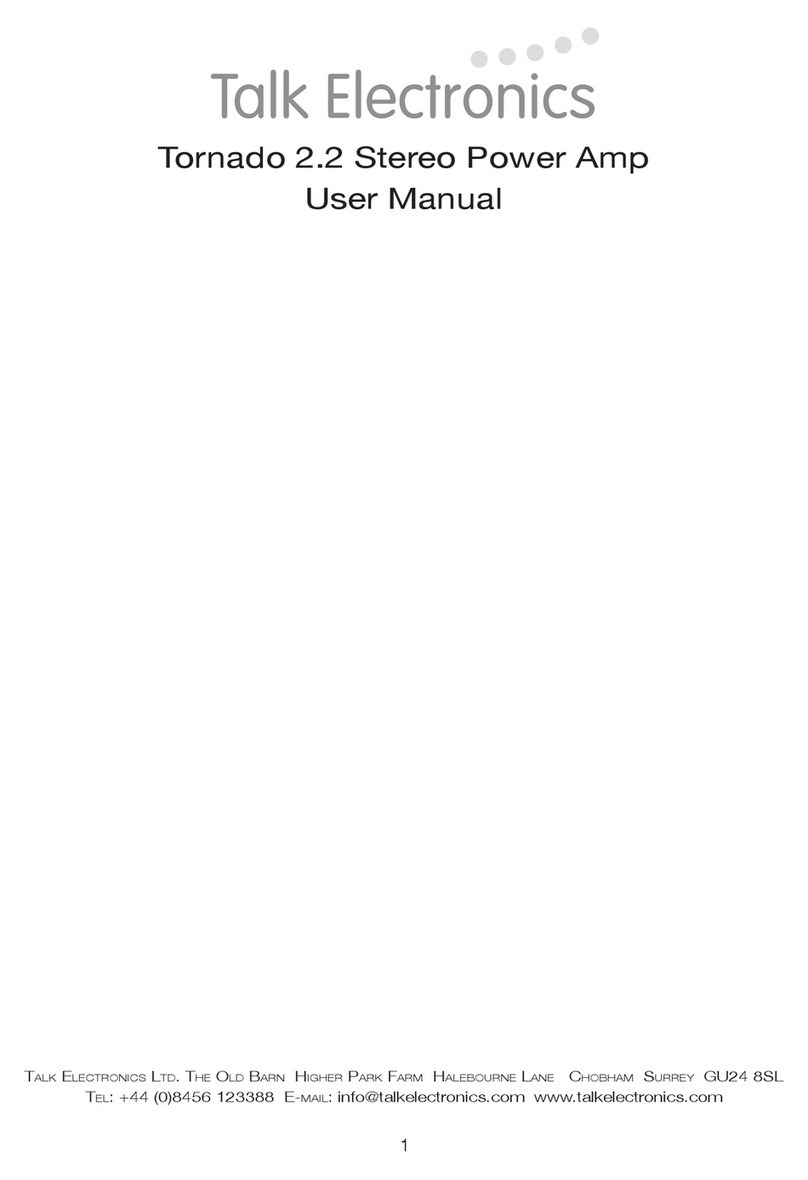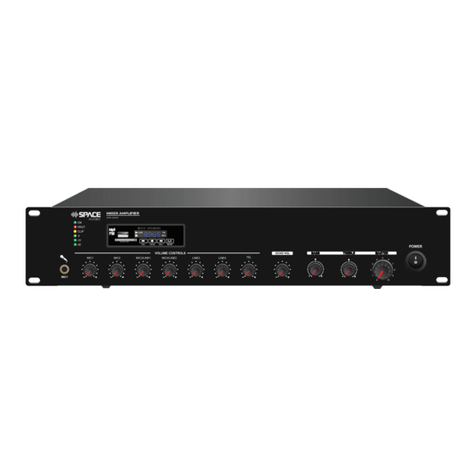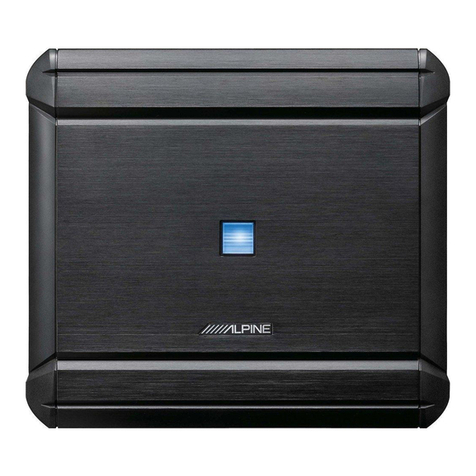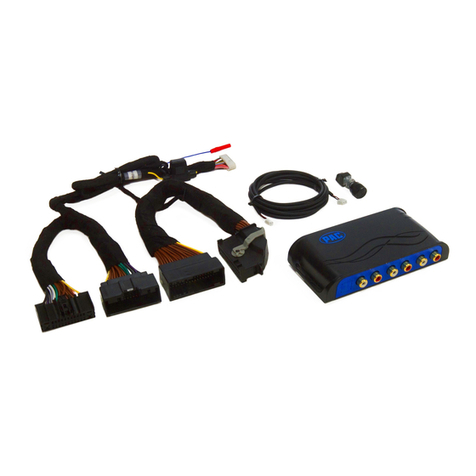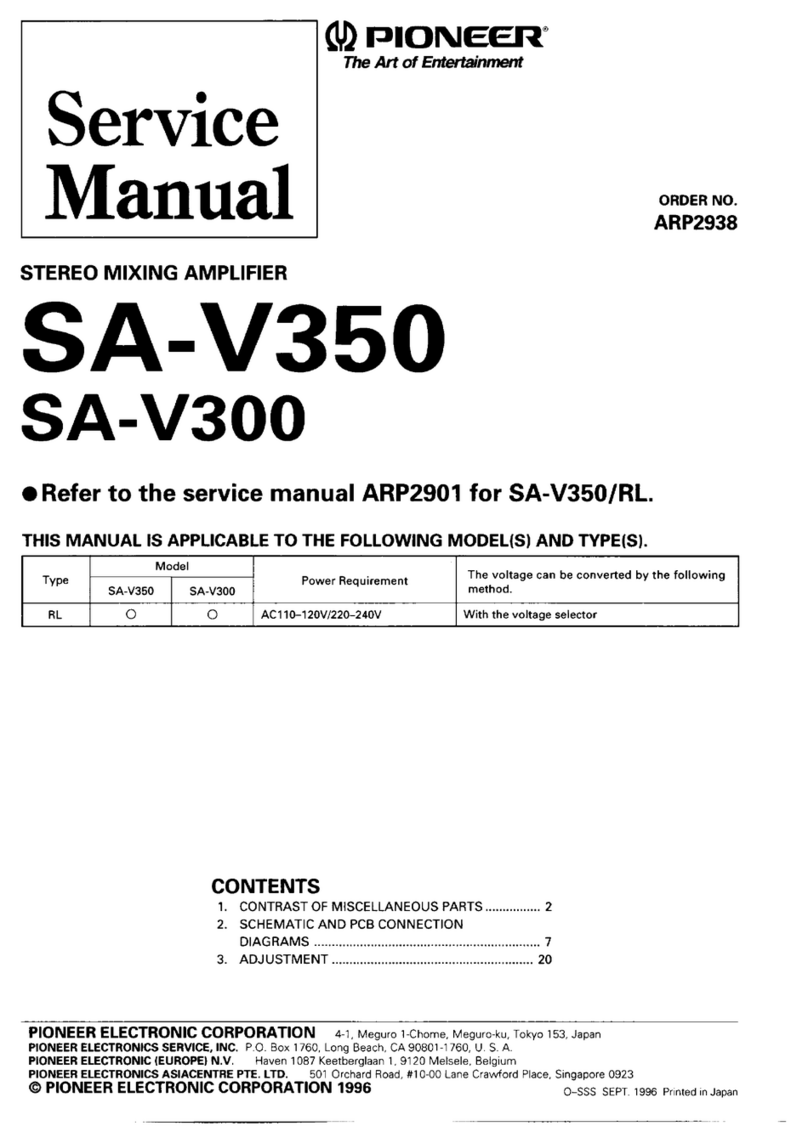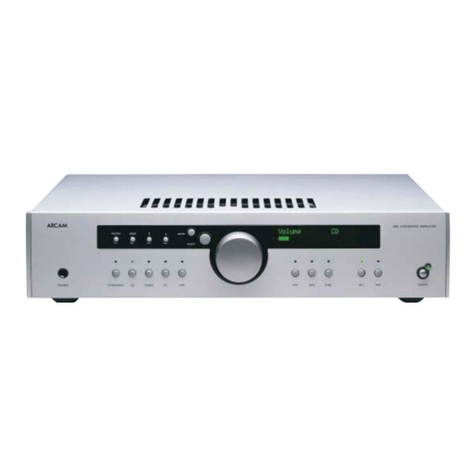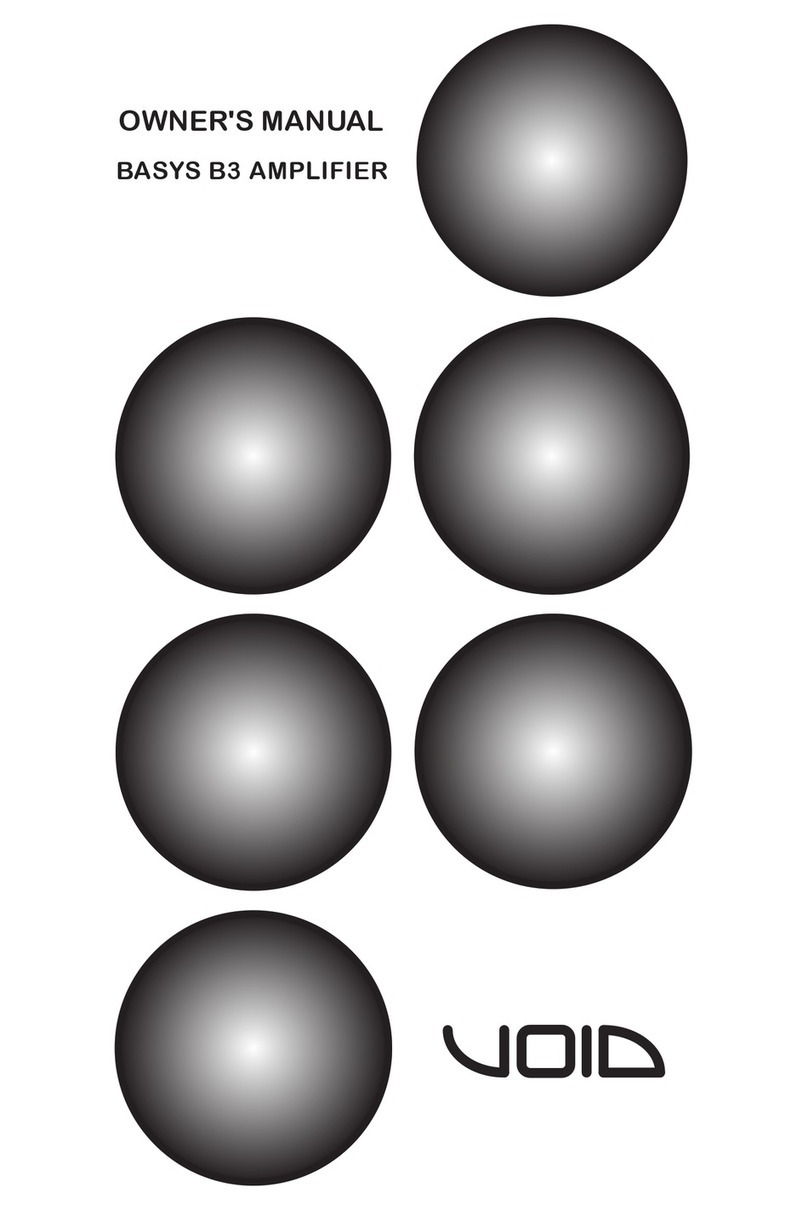Audionet HUMBOLDT User manual

-
User‘s Manual
HUMBOLDT


3
-
HUMBOLDT
Ultimate Analog Integrated Stereo Amplifier
User’s Manual
HANDMADE
IN BERLIN,
GERMANY

4
-

5
-
Contents
1Preface 7
1.1 Included items 8
1.2 Transport 8
2Overview front panel 9
3Overview back panel 10
4Installation and power supply 11
4.1 Placement 11
4.2 Mains connection 12
4.3 Orientation of mains plug 12
5Inputs and outputs 13
5.1 Line level inputs 13
5.2 Speaker terminals 13
5.3 Preamplifier outputs 14
5.3.1 Bi-Amping 14
5.4 Audionet Link 15
6Operating 17
6.1 Powering up 17
6.2 Switching on and off 18
6.3 Using Audionet Link 18
6.4 Control elements on the front panel 19
6.5 Volume control 19
6.6 Display 21
6.7 Input selection 22
6.8 Muting 23
7Setup Menu 25
7.1 Global settings: Menu 28
7.1.1 Display 28
7.1.2 Balance 29

6
-
7.1.3 Power 30
7.1.4 Serial 32
7.1.5 By-Pass 33
7.1.6 Network 39
7.1.7 Reset 43
7.1.8 Info 45
7.2 Channel settings: Options 48
7.2.1 Offset 48
7.2.2 DC Servo 49
7.2.3 Name 50
7.3 Overview of factory defaults 51
8Audionet Metal Remote Control 52
8.1 Key assignment 52
8.2 Changing the batteries 53
8.3 Settings for Audionet preamplifier 53
9AN-Ultimates Control App 55
10 Network setup 56
10.1 Connecting to a wireless network 56
10.2 Setting up the Access Point Mode 58
10.3 Network trouble shooting 58
10.4 Updating the HUMBOLDT 61
11 Protection system 63
11.1 Monitoring mains power voltage 65
12 Security advice 67
13 Technical information 69
14 Technical data 71

7
-
1Preface
The Audionet Scientists Team and its leading scholars congratulate you on your
purchase of this unit, sending cheers directly from our research and development
center.
Audionet components are no marketing products, they are authentic. Conceived
and developed with scientific inspiration, professional engineering expertise and
a deep passion for achieving the truly perfect sound. They are unique creations
designed to inspire musical enjoyment and have an excellent reputation amongst
all connoisseurs throughout the world. Each and every one of our precision-man-
ufactured devices is individually crafted by hand at our new Berlin headquarters.
Built by audiophiles for audiophiles. With the utmost precision and total control
of each and every perceptible detail.
Even if you're an experienced aficionado of ultra-highend components, please
start listening to your new Audionet HUMBOLDT by reading this manual care-
fully before you plug it in. This will ensure you'll enjoy all functions of this unit
without any compromise or potential disruption.

8
-
1.1 Included items
You will find the following items included:
Stereo integrated amplifier HUMBOLDT
Audionet Metal Remote Control
WIFI antenna
Power cord
Batteries for the remote control
Allen key for battery replacement
Covers for serial ports
Cover bag
Gloves, 2 pairs
User's manual (that you are currently reading)
Red warning note
Fumigation certificate
1.2 Transport
Important
Only transport the HUMBOLDT in the original packaging.
Always use the provided bag to prevent scratches on the casing.
Please allow the HUMBOLDT to adapt to the climatic conditions in your lis-
tening room before you switch the unit on for the first time after the
transport.

9
-
2Overview front panel
1power key
2rotary encoder
3keys (dynamically assigned functions)
4display
I
4
3
2

10
-
3Overview back panel
5balanced (XLR) in 1
6balanced (XLR) in 2
7line in 3
8line in 4
9line in 5
10 balanced (XLR) out
11 line out
12 speaker terminal
13 WLAN antenna socket
14 serial port (RS232)
15 ‘Audionet Link’ out 1
16 ‘Audionet Link’ out 2
17 additional ground terminal
18 ‘mains phase’ marking
19 mains power input
20 fuse compartment

11
-
4Installation and power supply
Important
While connecting and removing sources, amplifiers or speakers to the HUM-
BOLDT, all units of your audio system have to be switched off to prevent
damage to the HUMBOLDT or any connected units.
Please make sure that all cables are in absolute best conditions! Broken shields
or short-cut cables could damage the HUMBOLDT and/or any other unit
connected.
4.1 Placement
Important
It is recommended to place the HUMBOLDT into a high-quality rack or onto
a stable table.
Do not expose the unit to direct sunlight.
Do not place the HUMBOLDT in close range to heat sources like radiators.
Do not cover the ventilation openings on top of the HUMBOLDT.
Do not place any other unit on top of the HUMBOLDT.
Do not place the HUMBOLDT on top of other units. Especially not on top
of power amplifiers, preamplifiers or similar components that produce heat.
Both units could suffer damage from thermal overload.
Do not use the unit in places where it is exposed to vibrations.
Do not place the unit close to loudspeakers or into the corner of a room
where it is exposed to high levels of sonic energy, which might reduce the
sound quality.

12
-
4.2 Mains connection
The mains power input is on the back panel of the HUMBOLDT. Use the
included power cord to connect the unit to mains. If you prefer to use a different
power cord, make sure that it meets the specifications for your home country.
Important
The electrical specifications of your home country must meet the electrical
specifications printed onto the back panel.
The HUMBOLDT is a Class I unit and must be earthed. Please ensure a stable
earth connection. The phase ('hot' pin) is marked on the back panel ('PHASE')
.
Never pull the mains plug while the HUMBOLDT is switched on! Before you
pull the power cord off its socket at the back panel, power down the unit to
stand-by mode first.
The HUMBOLDT should only be switched off from the mains in cases of ex-
tended absence (like vacations) or if massive trouble on the mains power is to be
expected. Pull the power cord off the mains power input socket to completely
disconnect the unit from mains.
Tip
The use of high quality power cords could improve the sound quality. Please
ask your local retailer for more information.
4.3 Orientation of mains plug
The correct polarization of mains is important for reasons of audio clarity and
stability. Please connect the power cord so that the hot pin of the wall outlet is
connected to the pin of the mains power input marked with 'PHASE' .

13
-
5Inputs and outputs
Important
While connecting and removing sources, amplifiers or speakers to the HUM-
BOLDT, all units of your audio system have to be switched off to prevent
damage to the HUMBOLDT or any connected units.
Please make sure that all cables are in absolute best conditions! Broken shields
or short-cut cables could damage the HUMBOLDT and/or any other con-
nected unit.
5.1 Line level inputs
The HUMBOLDT is equipped with two balanced (XLR) '1' and '2' as well
as three Cinch (line) inputs '3' , '4' and '5' for connecting signal sources at
line level. Due to its double mono design, left and right channel input jacks are
separated on the back panel.
Please connect the left and right input of the same number printed on the back
panel of the HUMBOLDT to the corresponding output of the source which you
would like to connect to the HUMBOLDT.
5.2 Speaker terminals
Connect your speakers to the rhodium plated terminals SPEAKERS RIGHT and
SPEAKERS LEFT on the back panel of the HUMBOLDT. You may use banana
plugs or spades as well as simple cable ends. Fasten speaker terminals until the
torque stop clicks distinctly. The torque stop guarantees for the right fastening
torque at all times ensuring a safe contact.

14
-
Note
Look out for the correct connection of your speaker cables. Usually, the ter-
minals of your speakers are marked '+' and '-'. The HUMBOLDT uses the
same labels.
Wrong speaker polarization will result in severe loss of sound quality.
Important
Although the HUMBOLDT has an effective protection system to prevent
damage to the circuits, always switch off the unit while working on the
speaker and/or audio cables.
The nominal loudspeaker impedance should be 4 Ohms or higher.
Never use force or tools to tighten the terminal screws.
5.3 Preamplifier outputs
The HUMBOLDT is equipped with one balanced (XLR) and one Cinch (line)
output –left and right channel each –to connect the unit to additional ampli-
fier(s) (e.g. for bi-amping purposes) or subwoofer. The preamplifier outputs are
always active and provide a volume controlled full-range signal. Due to the double
mono design the left and right output jacks are separated.
Use the left and right Cinch (line) output to connect the HUMBOLDT to
additional power amplifier(s) or subwoofer using high quality Cinch cables. Alter-
natively, you may connect a power amplifier using the balanced (XLR) outputs
in case the additional power amplifier or subwoofer does not support Cinch (line)
inputs.
5.3.1 Bi-Amping
While bi-amping, each loudspeaker is controlled by two power amplifiers: one
amplifier for the bass range and one for the high- and midrange. Generally, this
setup leads to an increase of the sound quality.

15
-
For the purpose of bi-amping the HUMBOLDT has one Cinch (line) output or
one balanced (XLR) output for each channel. Thus, making it very easy to make
all the necessary connections for a bi-amping setup, e.g. using the HUMBOLDT
speaker outputs to connect to the high/midrange terminal of your speakers,
and connect an additional power amplifier to the bass range terminals of your
speaker.
Important
In most cases loudspeakers are equipped with bridges installed between the
terminals for bass and high/mid-range. These bridges have to be removed be-
fore you connect two power amplifiers to each speaker. Otherwise the
power amplifiers might get damaged!
Please consult the user’s manual of your speakers to find out if the speakers
support bi-amping and how they have to be set up correctly.
5.4 Audionet Link
For your convenience, the HUMBOLDT is able to switch all other Audionet units
(e.g. power amplifiers) on or off, that are connected via 'Audionet Link' (e.g. by a
simple touch on the included remote control or the power key on the front
panel).
Only a simple optical 'Toslink' cable is needed. Connect the 'Audionet Link' out-
put of your HUMBOLDT to the 'Audionet Link' input of unit to be controlled.
The HUMBOLDT is equipped with two identical 'Audionet Link' outputs. In case
you would like to control more than one Audionet unit via 'Audionet Link', use
the second 'Audionet Link' output of your HUMBOLDT as well.
The 'power on' signal of the 'Audionet Link' output 2 is slightly time-delayed
in regard to the 'Audionet Link' output 1 in order to prevent all by 'Audionet
Link' connected devices switching on at the same time. Otherwise this could re-
sult in an overload of your home fuse.

16
-
Tip
Audionet source units and power amplifiers are usually equipped with an 'Au-
dionet Link' input and additionally with an 'Audionet Link' output to connect
further Audionet devices to be controlled via 'Audionet Link' in a daisy chain.
Connect the 'Audionet Link' output to the 'Audionet Link' input of the next
unit, using a simple optical 'Toslink' cable. This will allow you to switch your
complete Audionet system on and off by your Audionet integrated amplifier.

17
-
6Operating
All functions of the HUMBOLDT are microprocessor controlled. This guarantees
highest precision, exclusive functions, easy handling and protection against oper-
ating errors.
6.1 Powering up
First of all, please make sure your HUMBOLDT is connected correctly to your
signal sources, speakers and mains power (refer to sections 'Installation and
power supply' on page 11 and 'Inputs and outputs' on page 13).
The HUMBOLDT is a stand-by unit. Please insert the power cord into the mains
input socket on the back panel and connect the HUMBOLDT to mains power.
The display shows a welcome message for a brief moment. After that the
HUMBOLDT is in stand-by mode. The display turns dark now.
The HUMBOLDT should only be switched off from the mains in cases of ex-
tended absence (like vacations) or if massive trouble on the mains power is to be
expected. Pull the mains plug off the mains input socket to completely discon-
nect the unit from mains.
Important
Never pull the power cord while the HUMBOLDT is up and running!
Before you disconnect the power cord, always power the unit down to stand-
by mode first.
If you disconnect the HUMBOLDT from mains power, first power down and
completely discharge all units connected to the outputs of the HUMBOLDT
first.

18
-
6.2 Switching on and off
Press the key on the front panel to power up the HUMBOLDT from stand-
by mode. The HUMBOLDT issues the message Waking up... and shows the normal
operating screen afterwards. The unit is in normal operating mode now.
If you would like to switch off the unit, please press the key on the front
panel. The display shows the message Going to sleep...
While the power supply of the HUMBOLDT is discharged the display shows
the message Discharging… please wait. After the discharging is done, the display
turns dark indicating that the unit is in stand-by mode now.
Note
Of course, you may switch the HUMBOLDT on and off with the included
Audionet Metal Remote Control. For detailed information please refer to
section 'Audionet Metal Remote Control' on page 52.
During powering down, you may re-start the HUMBOLDT by pressing the
the key on the front panel. The display shows the message Re-start-
ing...
6.3 Using Audionet Link
Your HUMBOLDT is equipped with two 'Audionet Link' outputs and , al-
lowing you to switch further Audionet units (e.g. power amplifiers, CD player or
tuner) on and off, if they are connected via 'Audionet Link' (refer to section
'Speaker terminals' on page 13).
If further Audionet units are connected to your HUMBOLDT via 'Audionet Link',
these linked units will be switched on and off automatically, as soon as you switch
the HUMBOLDT on and off by using the key on the front panel or the
remote control.

19
-
Note
The 'power on' signal is issued to the 'Audionet Link' output 2 of the HUM-
BOLDT with a small delay in order to prevent all connected from units pow-
ering up at the same time, which could overload your home fuse.
Please do read the section 'Speaker terminals' on page 13 and consult the
user's manuals of your Audionet components connected via 'Audionet Link'
for further information.
6.4 Control elements on the front panel
The front panel has six keys to control the HUMBOLDT (refer to section 'Over-
view front panel' on page 9). You can control all functions with these keys as well
as all setup options to adjust the unit to your preferences (see section 'Setup
Menu' on page 25).
Use the key to switch the HUMBOLDT on or off. There is a circular op-
erating indicator around the key, which lights up when the HUMBOLDT is up
and running, ready to play back music.
The five keys directly underneath the display are dynamically assigned with
functions by the current operating mode of the HUMBOLDT. The given function
of a key is shown as text in the display right above each key. If no text is displayed,
the key has no function in the present operating mode.
The rotary encoder is used to control the volume setting of the HUMBOLDT
(see the following section 'Volume control') but as well for navigating through the
menus and user options.
6.5 Volume control
The rotary encoder on the front panel of the HUMBOLDT is used to set the
desired volume level. Turn the rotary encoder clockwise to increase and counter
clockwise to decrease the volume.

20
-
The volume control of the HUMBOLDT has a range from –80 dB to +10 dB in
real 1 dB steps relatively to the level of the input signal. Differences in input levels
can be adjusted for each input channel of the HUMBOLDT separately (see section
'Offset' on page 48).
The rotary encoder is a magnetically buffered incremental impulse encoder with-
out an end stop.
The display shows the current volume level in dB during the change of the volume
level as well as a bar graph of the volume in an enlarged manner for a better
readability:
Several seconds after the last volume change the display will revert to the normal
operating screen.
Note
The rotary encoder is also used for navigating through the menus (see
section 'Setup Menu' on page 25) as well as for selecting the input channel
(see section 'Input selection' on page 22).
Use the keys 'VOL+' and 'VOL-' (see section 'Key assignment' on page 52)
to control the volume with the Audionet Metal Remote Control.
3 - Line Input
Volume
-44 dB
Menu Options Mute Input Info
Table of contents
Other Audionet Amplifier manuals
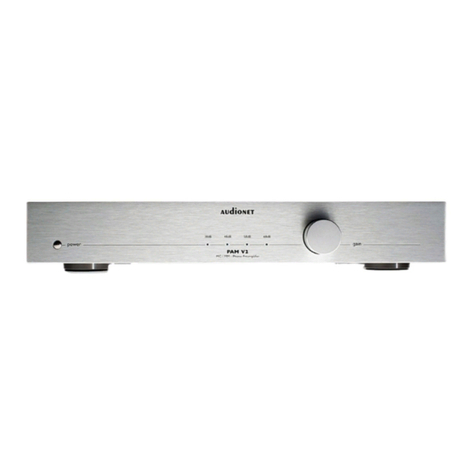
Audionet
Audionet PAM V2 User manual
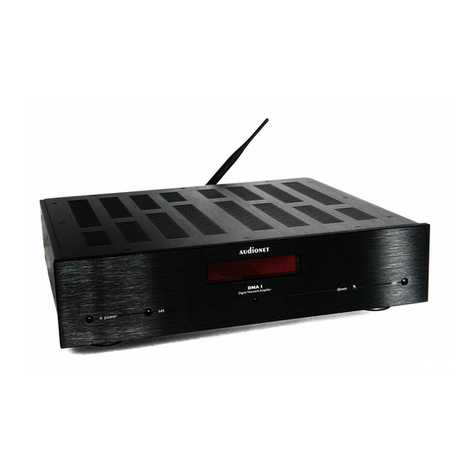
Audionet
Audionet DNA User manual
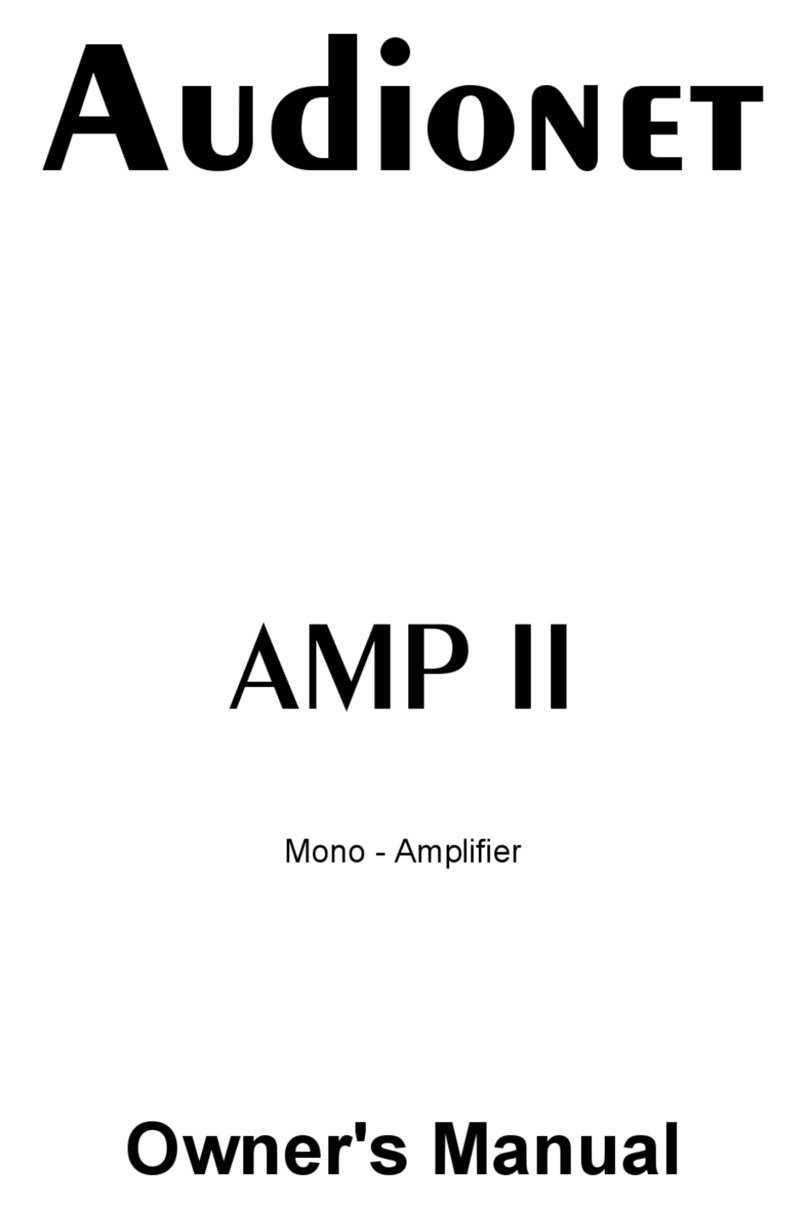
Audionet
Audionet AMP II MAX User manual
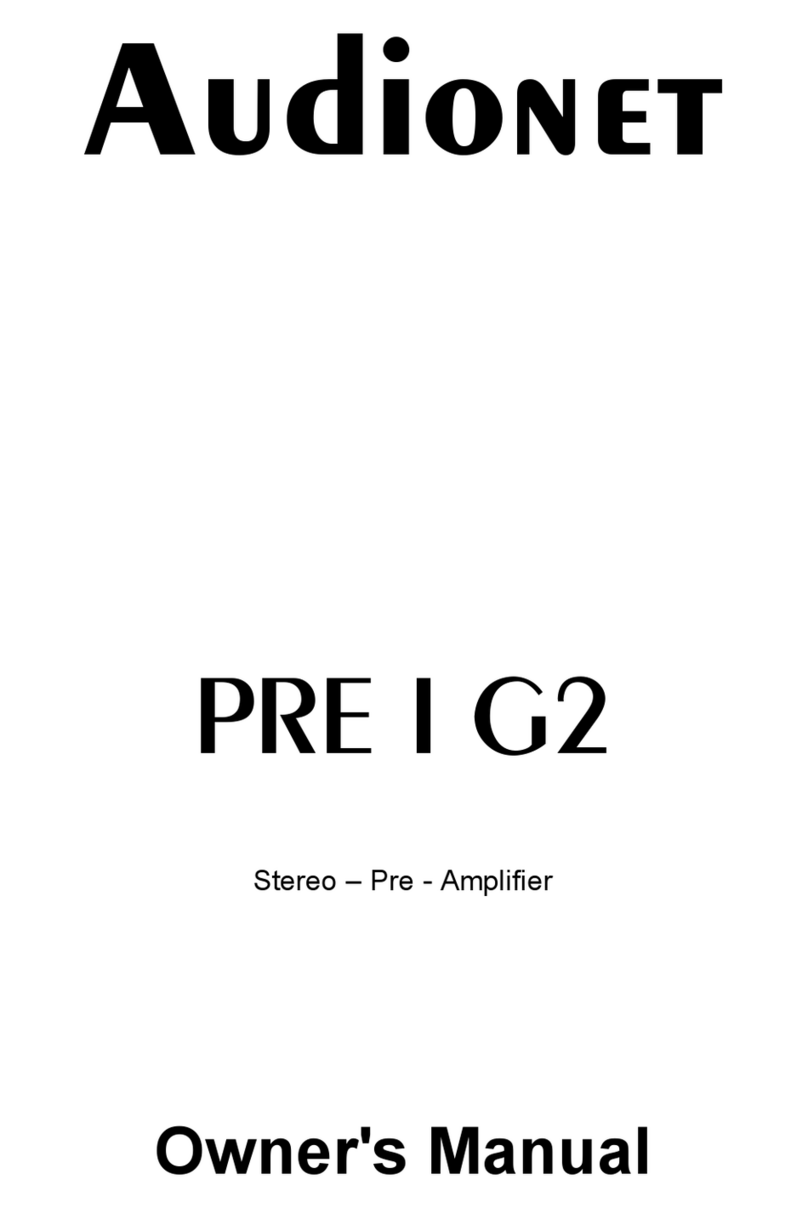
Audionet
Audionet PRE I G2 User manual
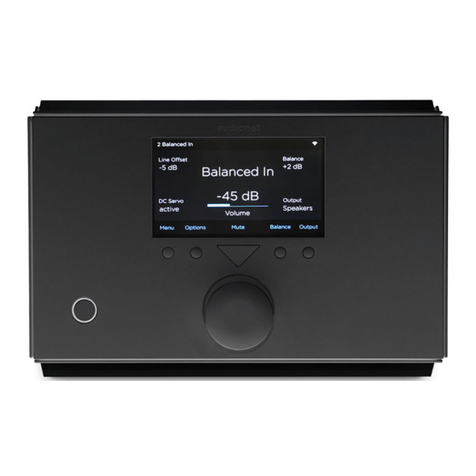
Audionet
Audionet STERN User manual

Audionet
Audionet DNA User manual
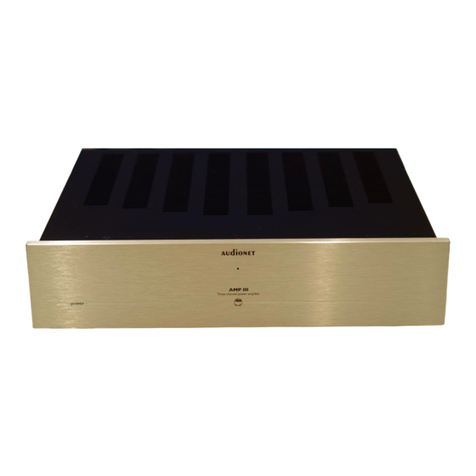
Audionet
Audionet AMP III User manual
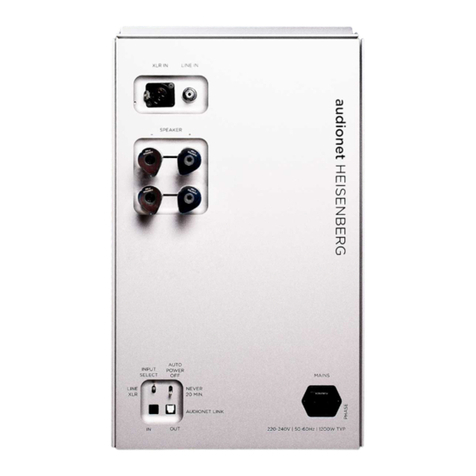
Audionet
Audionet HEISENBERG User manual
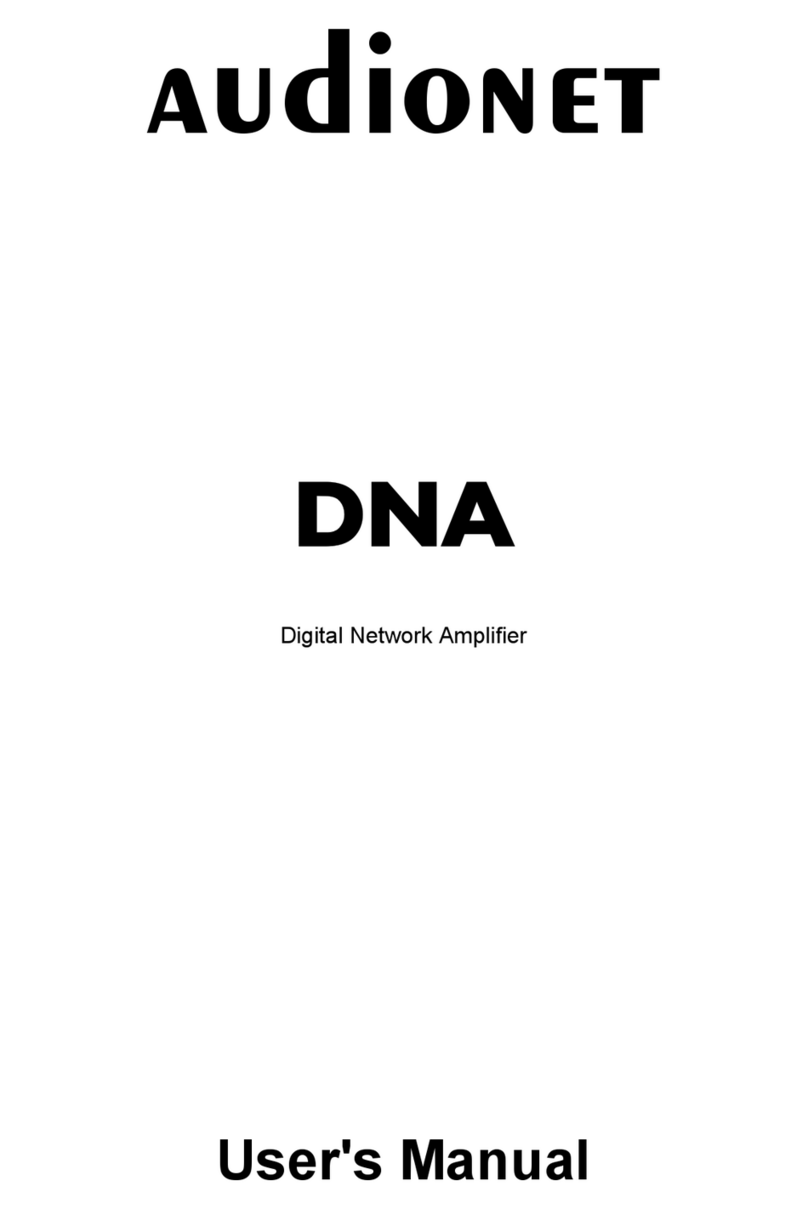
Audionet
Audionet DNA User manual
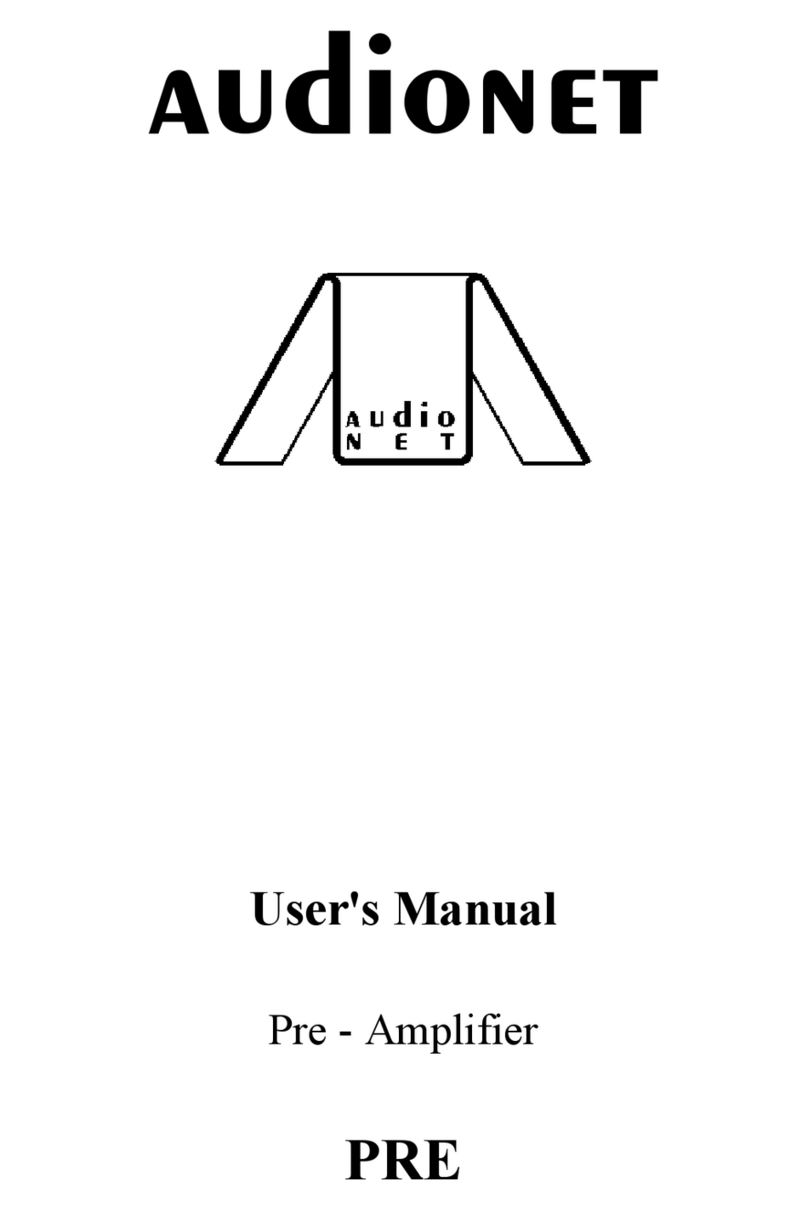
Audionet
Audionet PRE User manual
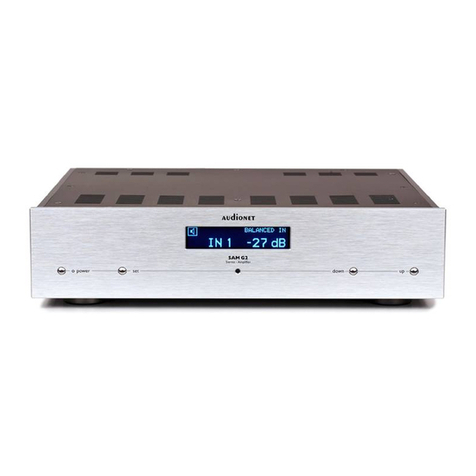
Audionet
Audionet SAM G2 User manual
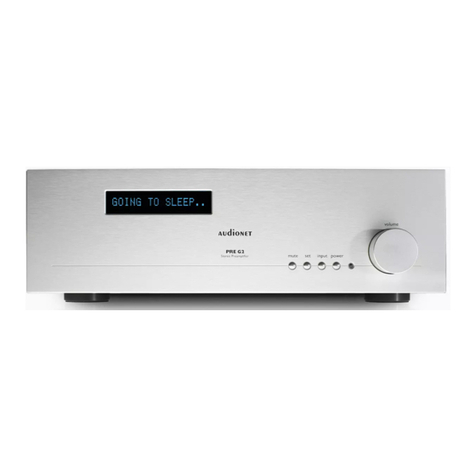
Audionet
Audionet PRE G2 User manual

Audionet
Audionet AMP III User manual

Audionet
Audionet PRE G2 User manual
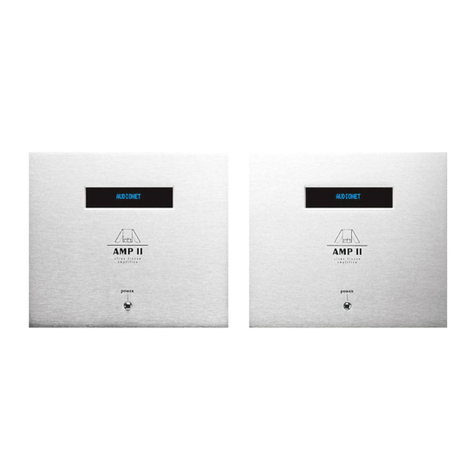
Audionet
Audionet AMP II MAX User manual
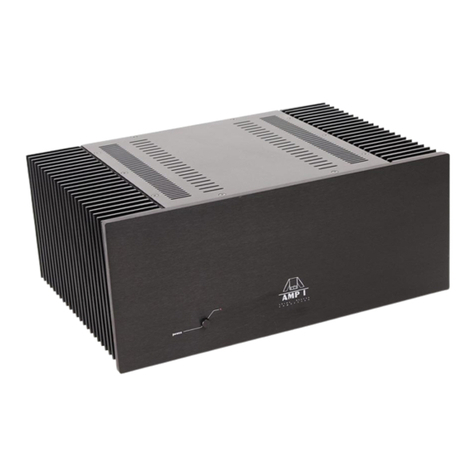
Audionet
Audionet AMP 1 User manual
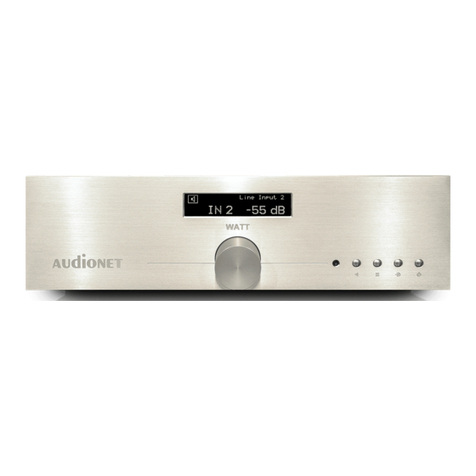
Audionet
Audionet WATT User manual

Audionet
Audionet MAP User manual

Audionet
Audionet Amp I V2 User manual
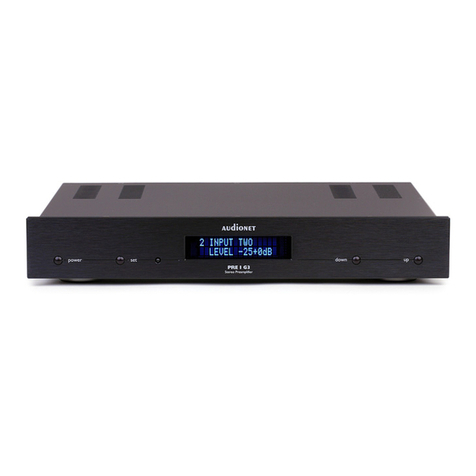
Audionet
Audionet PRE1 G3 User manual
